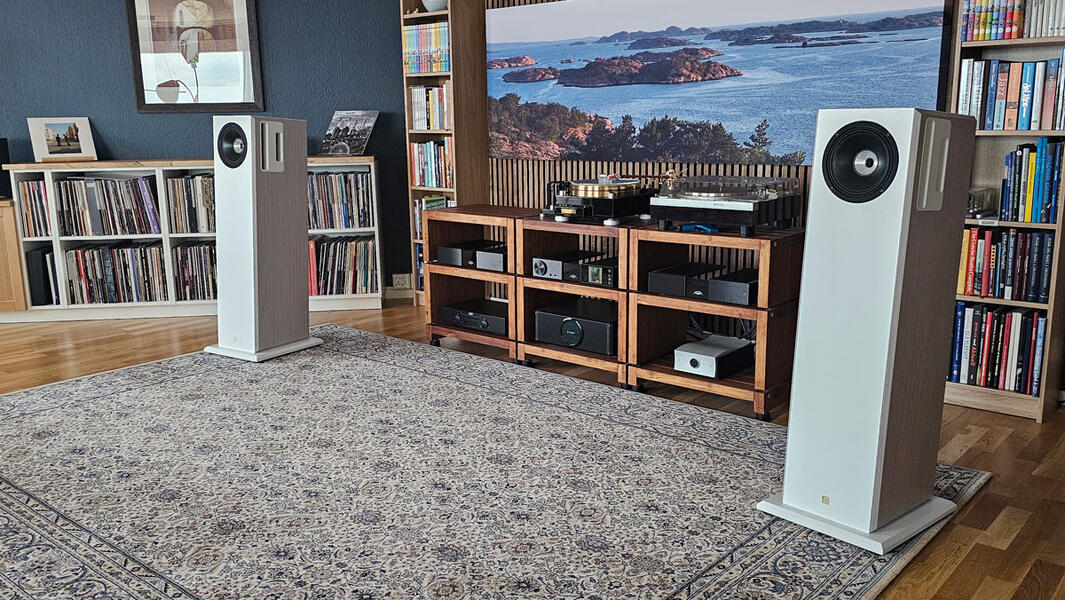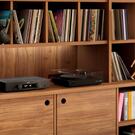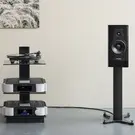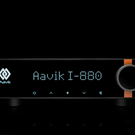"I think we’ll just leave them right there. No further adjustments needed," said Thorbjørn Sigberg, the man behind Sigberg Audio.
The Wizard of Ås
Thorbjørn Sigberg founded Sigberg Audio in April 2020, and just two months later launched his first product, the Inkognito subwoofer. The response was so overwhelmingly positive that people began referring to him as “The Wizard from Ås”—a nod to both his hometown and a certain classic film.
Since then, the product lineup has expanded to include another subwoofer and two active monitors, the SBS.1 and Manta. Both the subwoofers and loudspeakers have received critical acclaim in Norway and abroad, from both reviewers and customers. Sigberg has even gained a foothold in the professional audio market—a significant achievement. The Manta and SBS.1 both require subwoofers to reach full-range performance. Thus making the Sigberg Audio line-up less ideal for customers who don’t want subwoofers. Until now.
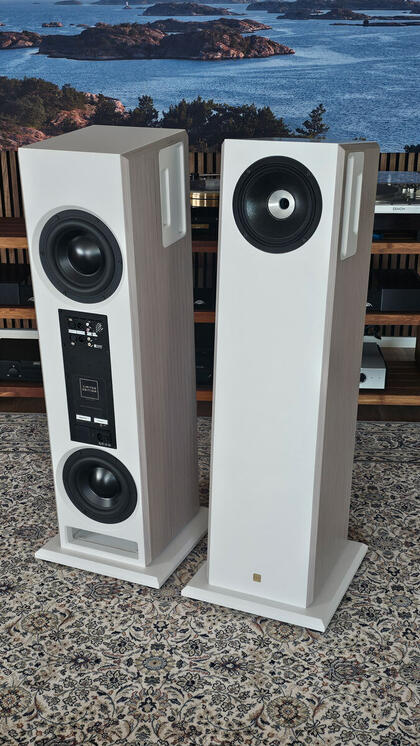
The first floorstander
Saranna is Sigberg Audio’s first floorstanding speaker—and the first speaker that doesn’t require a subwoofer or two to deliver deep bass. While the name 'Manta' was inspired by Thorbjørn’s uncle’s Opel, 'Saranna' is a tribute to his grandmothers, Sara and Anna. Don’t for a second think that the more sentimental name has resulted in any less punch than the previous model—named after a German sports car.
Sigberg refuses to compromise on his sonic ideals. Even though the speaker may appear relatively slim from the front, with an 8-inch coaxial driver housing a horn-loaded compression tweeter at its center, the front is, quite literally, just one side of the story.Turning the speaker around reveals two more 8-inch drivers from Wavecor. In reality, these are almost 9 inches in size and offer an impressive 12mm of excursion. Wavecor refers to them as 8¾-inch drivers. They roll off above 140 Hz and reach down to 28 Hz based on measurements and port tuning—but in typical rooms, they often go even deeper. Thorbjørn Sigberg notes that reaching down to 20 Hz is more the rule than the exception. In my nearly 50-square-meter room, with the speakers placed slightly farther out than recommended, the roll-off started just below 25 Hz—more than enough for most listeners. From the factory, the Saranna allows you to tweak bass below 100 Hz with three settings: flat, +2 dB, or -2 dB. These can be changed via a PC connection. That makes the speakers relatively easy to tune for typical rooms, where bass often presents the biggest challenge. In my case, I adjusted them to 0, +1 dB, and +2 dB—since I didn’t need any bass cut. Depending on the recording, I used +1 dB most of the time during testing.
Of course, there’s far more adjustment available beyond the factory presets.
Each speaker contains a powerful three-channel, 600-watt Hypex nCore amplifier with built-in digital signal processing (DSP) and a 9-band parametric equalizer. So you’ve got every opportunity to completely mess things up—or dial it in to absolute perfection. If you want to go down that road, a measurement microphone is essential (not included). However, the software and a USB cable for connecting to the speakers are provided.
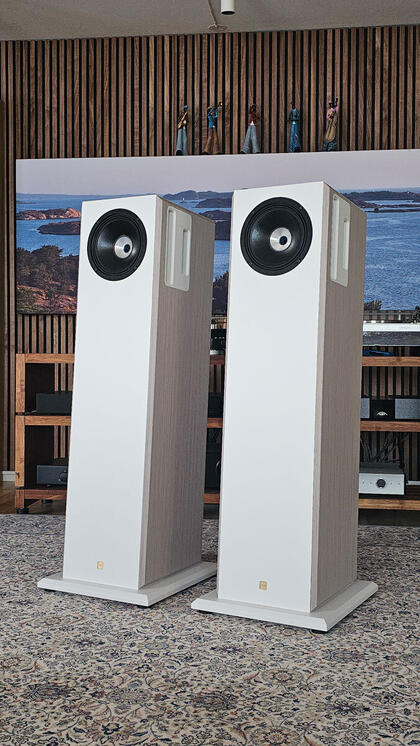
Cardioid loudspeakers
Bass tuning isn’t the only reason Saranna is easy to integrate in the room. It also borrows a critical design element from the Manta model—cardioid dispersion.
That means the Saranna doesn’t radiate sound like normal speakers. The side vents release sound in opposite phase to what’s coming from the front driver, reducing side and rear output. This gives you two major benefits: you can place the speakers closer to walls without negative effects, and room reflections are minimized—resulting in clearer, more focused sound and also a larger soundstage.
With the Saranna, the cardioid effect works from about 130 Hz up to 5 kHz—covering the crucial midrange, midbass, and parts of the treble.
Amplifier and connections
Between the two rear drivers sits the Hypex amplifier module—technically three mono amps: two at 250 watts, and one at 100 watts. In Saranna, the 100-watt amp drives the tweeter, one 250-watt amp powers the front coaxial woofer, and the other handles the two rear bass drivers.
You can look at it like a monoblock amplifier integrated into each speaker, that can be connected via balanced XLR or unbalanced RCA from a preamp or volume-controlled source. You can also connect digital sources directly via optical Toslink, coaxial S/PDIF, or AES/EBU. Optical supports up to 24-bit/96 kHz, while coaxial and AES handle up to 24-bit/192 kHz.
You can also route the signal to just one speaker and daisy-chain to the second using XLR, coax, or AES. This is helpful when electronics aren’t placed between the speakers.
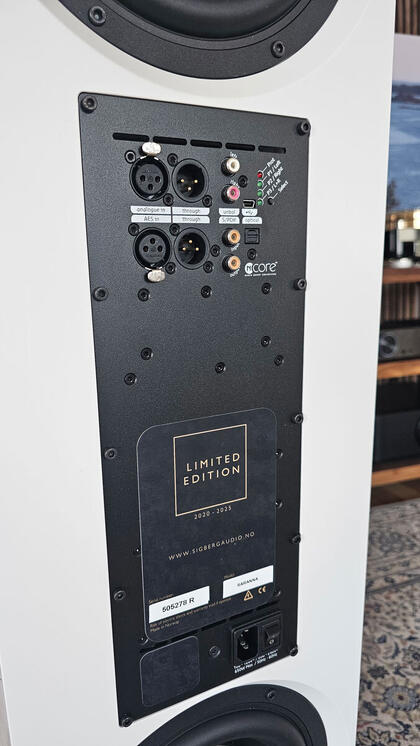
Design
On the back, a small button lets you cycle through the three factory EQ presets. A green LED indicates the active setting.
Starting from the bottom, the rear is made up by the bass reflex port, followed by the lower rear woofer, the amp module, and the upper rear woofer. The power input sits about 40 cm off the floor, and the analog/digital inputs another 30 cm higher. If your speakers are close to the wall, this doesn’t matter, but when placed farther out, it’s visually more elegant to have connections closer to the base. This isn’t unique to Saranna—many actives share this issue.
With active speakers that lack wireless input, each speaker needs both power and signal cables—twice as many as a traditional passive pair. The dream would be a Saranna with built-in streaming, app-controlled volume, and wireless speaker-to-speaker connection. Then you'd only need power cables for a complete system. Still, the current Saranna offers extraordinary performance and integration. You're getting speakers meticulously matched to their amplifiers—while the option of tweaking with preamps and sources is still available.
Aesthetically, the Saranna comes in two finishes: 'Shady White' and 'Fade to Black.' The light version has a grey, almost white cabinet with gray-white wood veneer side panels—elegant and understated. 'Fade to Black' features a cabinet with black paint and very dark wood veneer sides.
If I could request a third finish, it would be the same black cabinet from 'Fade to Black' but with walnut veneer sides. I think that would have looked amazing and would have been an aesthetic nod to the Sigberg Manta, which features a walnut base.
The Saranna includes a 38 x 42 cm base plate that adds stability without compromising the elegant, slightly reclined silhouette. You can mount the included Egeland Acoustics feet either directly into the cabinet or into the base. These offer absorbing floor decoupling tailored to the speaker’s weight.
Throughout the review period, I used the base and feet. The speakers were placed about 60 cm out from the wall, giving nearly 90 cm from the front baffle to the rear wall. I also tested them as close as 20 cm from a bookcase—no major issues, except a slight reduction in perceived depth of soundstage.
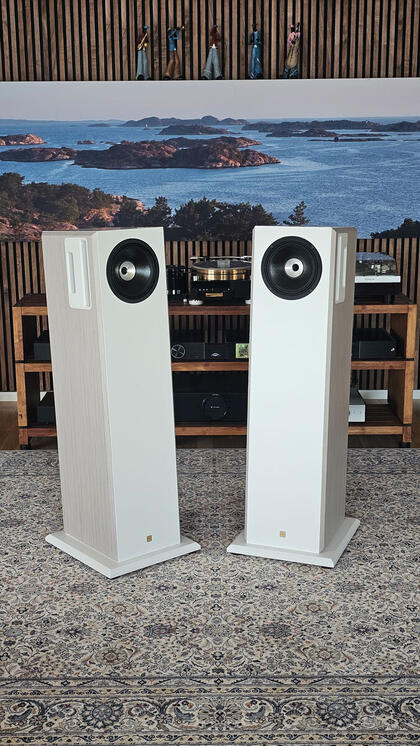
The sound
I must start with a confession. When I reviewed the Sigberg Audio SBS.1 with two 10D subwoofers, I was very impressed by the sound. Intellectually. Everything was technically correct—even in my small room at the time, bass was tight and powerful. Still, it didn’t quite move me emotionally. I had a similar reaction to the Sarannas at the Oslo HiFi Show—it sounded great, but I missed that emotional connection. The midrange soul, the magic. It sounded right, but was it right for me?
So when Saranna arrived at my home, I feared the same result. Would they sound clinical? Would they require extensive tweaking with microphones, target curves, and DSP settings? But once unboxed and placed roughly where my Harbeths usually stand, Thorbjørn didn’t even reach for the measurement mic. He just said, 'Put on some music.'
Three seconds later, all my doubts vanished. The sound hit me straight in the gut—and the heart. It sounded so good that I nearly cried. But with the manufacturer still in the room, I tried to keep it together. Thorbjørn Sigberg’s smile suggested I wasn’t hiding it well. Lady Gaga might have a poker face. Apparently I don’t.
That the bass was superior to my Harbeths didn’t surprise me—Sigberg’s background in subwoofers made that a given. But the punch and dynamic presence, even deep into the bass, was stunning. It’s also a real pleasure to hear nearly full-range bass response when you’re used to speakers that start rolling off around 35 hertz. There’s crucial spatial information below 30 Hz, and Saranna delivers it. What’s more, the bass isn’t dry or clinical—it’s full, rich, and powerful without becoming bloated. If anything, some might prefer a bit more edge, but that’s easily adjusted through the DSP settings, if needed with the help from Sigberg.
I did manage to push the room into saturation at one point—max boost, heavy bass track, high volume—but under normal use, there were zero issues. Tracks like 'Fading Sun' by Terje Isungset, 'Queen Mary' by Francine Thirteen, and 'Crystal Ball' by Carolin No showcased Saranna’s control and weight beautifully. As I sit here it’s hard to imagine living without the level of punch and depth that Saranna delivers.
Still, it wasn’t the bass that impressed me the most, but the midrange. God almighty! In this most important frequency range—where voices and solo instruments typically reside—there was certainly no longing for more emotion or soul. The transparency and detail are abundant, but it was the richness and subtle extra warmth in the midrange that truly won me over. It’s simply amazing, whether it’s the voice of Leonard Cohen, Sinne Eeg, or Cecilia Bartoli. And it’s so controlled that the speakers deliver regardless of musical genre. Acoustic jazz and chamber music sound amazing. So do Rammstein, Tool, and Wagner.
To be fair, I’ve heard speakers with even more air and openness in the highs, like my own Harbeths. But they cost nearly as much as Saranna and don’t include amps. Not that there’s any real sense of missing air or detail in the upper range with Sigberg’s active floorstanders either. The presentation is so coherent across the entire frequency range that you get the same level of sound quality, dynamics, resolution, and tonal richness in the entire frequency range.
Another thing that truly impressed me was the reproduction of the recording space. It’s vast and precise. The female voice in the intro of Three Wishes from Roger Waters’ Amused to Death stands rock solid, 90 degrees out to the left, while the sound effects in Caverna Magica by Andreas Vollenweider unfold outward and backward with millimeter precision. It sounds nothing short of phenomenal.

Conclusion
In church, 'Hosanna in the Highest' is a hymn of praise and a cry for salvation. And with the Sigberg Saranna in your system, it’s easy to feel saved, musically speaking. But in this case, it’s Thorbjørn Sigberg who deserves the praise, because the Saranna is truly a magnificent loudspeaker.
If he had added a toggle switch, a pair of standard speaker terminals, and a passive crossover, just so I could use them passively when reviewing amplifiers for Stereo+, I would’ve started saving for a pair immediately.
As it stands, I’ll have to stick with the dream for now, since active speakers are a bit impractical for a hi-fi journalist. But until Sigberg comes to collect them, I suppose I’ll just have to sing a little myself. Saranna in the highest!

 Vipps oss en gave: 129702
Vipps oss en gave: 129702